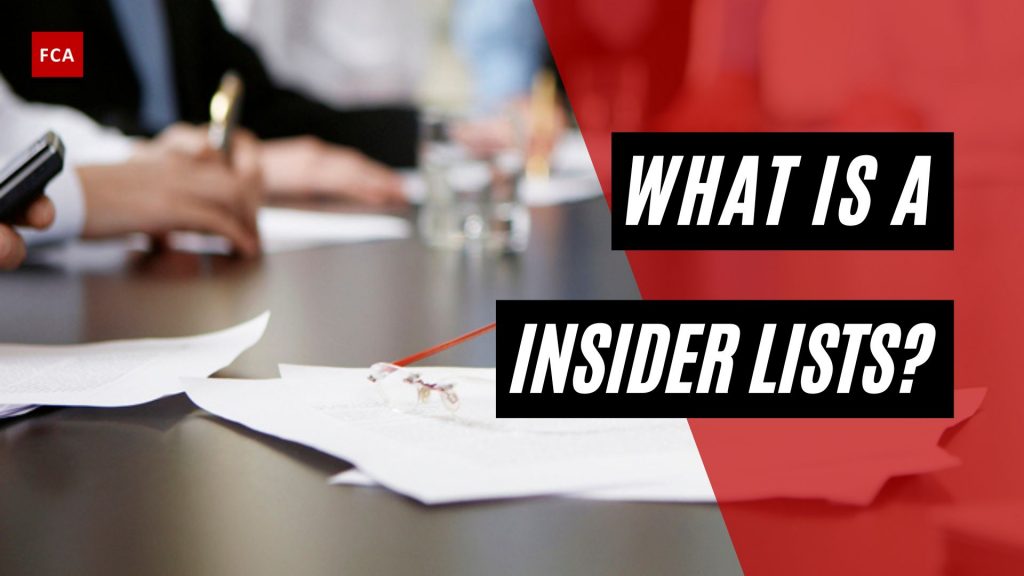What is a insider lists? Securities brokers, agents, and management of the company dealing in financial securities must maintain the insider lists. The list serves as a record to identify the persons who were found in the activities related to insider trading.

What Is A Insider Lists?
An insider may be a person or persons charged with the execution of orders concerning financial instruments, receiving information conveyed by a client, and relating to the client’s pending orders in financial instruments, relating, directly or indirectly, to one or more issuers or one or more financial instruments, and which, if it were made public, would be likely to have a significant effect on the prices of those financial instruments, the price of related spot commodity contracts, or on the price of related derivative financial instruments. (Article 7 (1 )d of the MAR).
Precise Information
The insider may have a piece of precise information, which means the information that concerns a set of circumstances that exist or which may reasonably be expected to come into existence. An event that has occurred or which may reasonably be expected to occur should be recorded and, where a conclusion may be drawn as to the possible occurrence of insider trading, the possible effects and the names of the suspected insider must be recorded.
List of Insider
An insider list is required to be prepared, and maintained by the companies, on a timely basis, to identify those persons who fall into the scope of the Insider, and for whom appropriate controls need to be implemented, to avoid the risks of insider dealing, and trading.
The existing requirement for issuers of instruments to maintain an insider list comprised of employees and advisers who have inside information has been enhanced. In the future, the content and form of insider lists will be set out more prescriptively to establish a harmonized standard across all member states.
The concept of keeping insider lists of those people who have access to a company’s inside information before it is published is well established. Companies are required to keep insider lists under MAR in a similar way to that under the Market Abuse Directive.
MAR requires companies or anyone acting on their behalf to:
- Draw up a list of all persons who have access to inside information and who are working for them under a contract of employment, or otherwise performing tasks through which they have access to inside information, such as advisers, accountants, or credit rating agencies;
- Promptly update the insider list; and
- Provide the insider list to the FCA as soon as possible upon its request.
In addition, companies must take all reasonable steps to ensure that any person on the insider list acknowledges in writing the legal and regulatory duties entailed and is aware of the sanctions applicable to insider dealing and unlawful disclosure of inside information. Where another person acting on behalf of the company, usually an advisor, assumes the task of drawing up and updating an insider list, the company remains fully responsible for complying with the regulations and the company must always retain a right of access to the insider list.
What Must An Insider List Contain?
The information required to be on the insider list has been expanded to include additional information such as not just the date but the time the person obtained or ceased to have inside information, telephone numbers, addresses, and identification numbers. Companies are required to ensure that they have access to or can obtain the necessary personal information which may be through HR departments. Generally, companies must ensure careful management and protection of inside information and who has access to files whether in hard copy or electronically. The aim should be to restrict access to as few people as possible on a need-to-know basis only.
Insider lists will include personal details of the insider’s date of birth, national identification number, addresses, telephone numbers, and also the date and time and the reason that the individual has been included on the insider list. Significantly, MAR codifies the decision of the Court of Justice of the European Union in the so-called “Spector Photo” case.
Spector Photo Group was a publicly listed company in Belgian. It operated a stock option program for employees. To transfer shares to employees, Spector purchased its shares on the market by using the services of Van Raemdonck. Following the purchase, Spector announced a takeover by its subsidiary of a rival company and disclosed Spector’s financial results, leading to an increase in share price.
The financial regulator investigated the purchases, found insider dealing is performed, and imposed fines. The respondents brought an appeal before a higher court.
In the Spector Photo case, the European Court of Justice (ECJ) handed down a judgment on the interpretation of Article 2(1) of the Market Abuse Directive (MAD), which contains a pan-European prohibition on insider trading. The ECJ held that national authorities do not need to demonstrate that the person accused of insider trading had used information with full knowledge. Instead, there was a presumption that a person who had inside information used that information in contravention of the insider dealing restrictions.
Final Thoughts
The disclosure of inside information and insider lists is currently required under the Disclosure and Transparency Rules (DTR). This will change when the Market Abuse Regulation (MAR) goes into effect on July 3, 2016. The Financial Conduct Authority (FCA) intends to replace the relevant provisions of the Disclosure and Transparency Rules with MAR provisions, and direct links to MAR will be provided rather than copying out the text.
As a result, the FCA has stated that the DTR will become “guidance” rather than “rules.” Having said that, a large proportion of the new requirements on information disclosure and insider lists under MAR remain the same as under the current Market Abuse Directive requirements as set out in the Disclosure and Transparency Rules.








